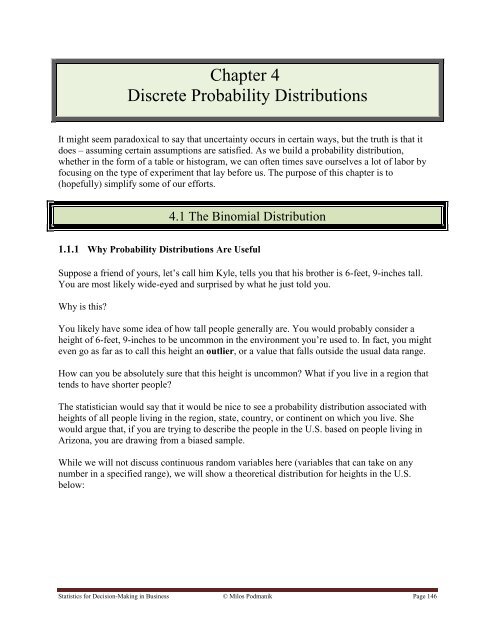Statistics for Decision- Making in Business - Maricopa Community ...
Statistics for Decision- Making in Business - Maricopa Community ...
Statistics for Decision- Making in Business - Maricopa Community ...
You also want an ePaper? Increase the reach of your titles
YUMPU automatically turns print PDFs into web optimized ePapers that Google loves.
Chapter 4<br />
Discrete Probability Distributions<br />
It might seem paradoxical to say that uncerta<strong>in</strong>ty occurs <strong>in</strong> certa<strong>in</strong> ways, but the truth is that it<br />
does – assum<strong>in</strong>g certa<strong>in</strong> assumptions are satisfied. As we build a probability distribution,<br />
whether <strong>in</strong> the <strong>for</strong>m of a table or histogram, we can often times save ourselves a lot of labor by<br />
focus<strong>in</strong>g on the type of experiment that lay be<strong>for</strong>e us. The purpose of this chapter is to<br />
(hopefully) simplify some of our ef<strong>for</strong>ts.<br />
4.1 The B<strong>in</strong>omial Distribution<br />
1.1.1 Why Probability Distributions Are Useful<br />
Suppose a friend of yours, let‟s call him Kyle, tells you that his brother is 6-feet, 9-<strong>in</strong>ches tall.<br />
You are most likely wide-eyed and surprised by what he just told you.<br />
Why is this<br />
You likely have some idea of how tall people generally are. You would probably consider a<br />
height of 6-feet, 9-<strong>in</strong>ches to be uncommon <strong>in</strong> the environment you‟re used to. In fact, you might<br />
even go as far as to call this height an outlier, or a value that falls outside the usual data range.<br />
How can you be absolutely sure that this height is uncommon What if you live <strong>in</strong> a region that<br />
tends to have shorter people<br />
The statistician would say that it would be nice to see a probability distribution associated with<br />
heights of all people liv<strong>in</strong>g <strong>in</strong> the region, state, country, or cont<strong>in</strong>ent on which you live. She<br />
would argue that, if you are try<strong>in</strong>g to describe the people <strong>in</strong> the U.S. based on people liv<strong>in</strong>g <strong>in</strong><br />
Arizona, you are draw<strong>in</strong>g from a biased sample.<br />
While we will not discuss cont<strong>in</strong>uous random variables here (variables that can take on any<br />
number <strong>in</strong> a specified range), we will show a theoretical distribution <strong>for</strong> heights <strong>in</strong> the U.S.<br />
below:<br />
<strong>Statistics</strong> <strong>for</strong> <strong>Decision</strong>-<strong>Mak<strong>in</strong>g</strong> <strong>in</strong> Bus<strong>in</strong>ess © Milos Podmanik Page 146
















